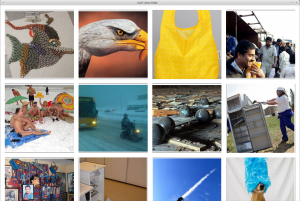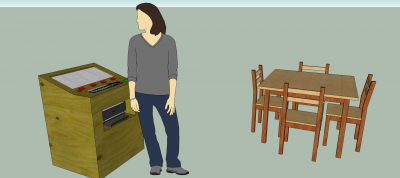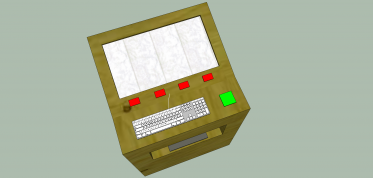User:Mirjam Dissel/interim assessment: Difference between revisions
| (9 intermediate revisions by the same user not shown) | |||
| Line 4: | Line 4: | ||
The machine looks like some sort of box with a computer screen in it, which you can operate via a number of buttons. It uses a slot machine mechanism and has 4 columns of random images set up, instead of lemons, apples or pears. The row of chosen images has a meaning. The images will come from scraped data, as random as possible to ensure free association.<br> | The machine looks like some sort of box with a computer screen in it, which you can operate via a number of buttons. It uses a slot machine mechanism and has 4 columns of random images set up, instead of lemons, apples or pears. The row of chosen images has a meaning. The images will come from scraped data, as random as possible to ensure free association.<br> | ||
By giving the subject boundaries I force them to make associations. They can change the images in the set by spinning the wheels. Here the theory of free association by Freud comes in once more. One lets things pass and accumulate for a bit and then the ideas get assessed. Like a collage a set is collected that is meaningful to the user. <br><br> | By giving the subject boundaries I force them to make associations. They can change the images in the set by spinning the wheels. Here the theory of free association by Freud comes in once more. One lets things pass and accumulate for a bit and then the ideas get assessed. Like a collage a set is collected that is meaningful to the user. <br><br> | ||
After this the user writes the topic of the set (a name, a sentence, a thought) and names the individual cards and then prints them. | After this the user writes the topic of the set (a name, a sentence, a thought) and possibly the names the individual cards and then prints them. | ||
This gives me a peek into their inner self, into their mind and brain. | This gives me a peek into their inner self, into their mind and brain. | ||
On the table next to it, people can play the quartet (go fish) game they have just printed out and mix their decks and interpret each other's sets.<br><br> | On the table next to it, people can play the quartet (go fish) game they have just printed out and mix their decks and interpret each other's sets.<br><br> | ||
| Line 17: | Line 17: | ||
[[File:Cover Beltran.jpg|200px]] [[File:2012-04-22 19.04.08.jpg|211px]] | [[File:Cover Beltran.jpg|200px]] [[File:2012-04-22 19.04.08.jpg|211px]] | ||
<br><br> | <br><br> | ||
== Demonstration == | == Demonstration == | ||
[[File:Associationmachine.png|300px | [[File:Associationmachine.png|300px]] | ||
*show working demo | *show working demo | ||
=== Work Files === | === Work Files === | ||
* image scraper | *[[User:Mirjam Dissel/image scraper|image scraper]] | ||
*[[User:Mirjam Dissel/image converter|image converter]] | *[[User:Mirjam Dissel/image converter|image converter]] | ||
*[[User:Mirjam Dissel/association machine|association machine]] | *[[User:Mirjam Dissel/association machine|association machine]] | ||
* send to inkscape file (quartet) | * send to inkscape file (quartet) | ||
* print | * print | ||
Latest revision as of 21:00, 9 May 2012
Project description
I'm making a machine that allows the user to make associations that lie deep within them; these are personal for each user.
The machine looks like some sort of box with a computer screen in it, which you can operate via a number of buttons. It uses a slot machine mechanism and has 4 columns of random images set up, instead of lemons, apples or pears. The row of chosen images has a meaning. The images will come from scraped data, as random as possible to ensure free association.
By giving the subject boundaries I force them to make associations. They can change the images in the set by spinning the wheels. Here the theory of free association by Freud comes in once more. One lets things pass and accumulate for a bit and then the ideas get assessed. Like a collage a set is collected that is meaningful to the user.
After this the user writes the topic of the set (a name, a sentence, a thought) and possibly the names the individual cards and then prints them.
This gives me a peek into their inner self, into their mind and brain.
On the table next to it, people can play the quartet (go fish) game they have just printed out and mix their decks and interpret each other's sets.
What will I do with the data collected? The topic will become the title of an encyclopedia page. The images will be superimposed, and will then become a page in the encyclopedia in which each page reflects a personal association.
My aim therefore is collecting different types of results, whether it will be personal results based on experiences from people, or something they associate through popular culture, current events, etc.
Example of previous work where I superimposed multiple scans of a collective of people's work.
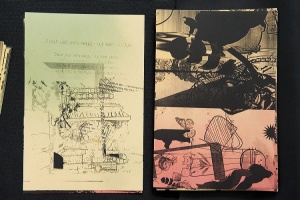
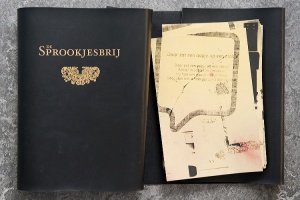
"The World Explained". Example of an encyclopedia seen from a microhistoric perspective. With personal theories on distant subjects.
By Erick Beltràn, Tropenmuseum 2012
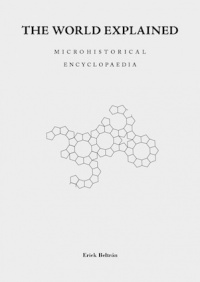

Demonstration
- show working demo
Work Files
- image scraper
- image converter
- association machine
- send to inkscape file (quartet)
- either send to inkscape file (encyclopedia page), or send images+title/imageNames+title to folder and then another script can send to inkscape (this way I also have the data of which images are used most, but what will I do with it?)
- print (but I can do this manually, or have a script make a pdf first)
What will it look like?
Thesis
My thesis will be sort of an explanation of my project, an extension of this.

